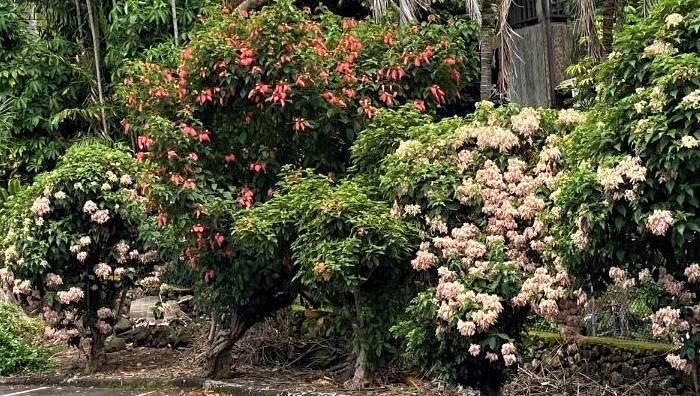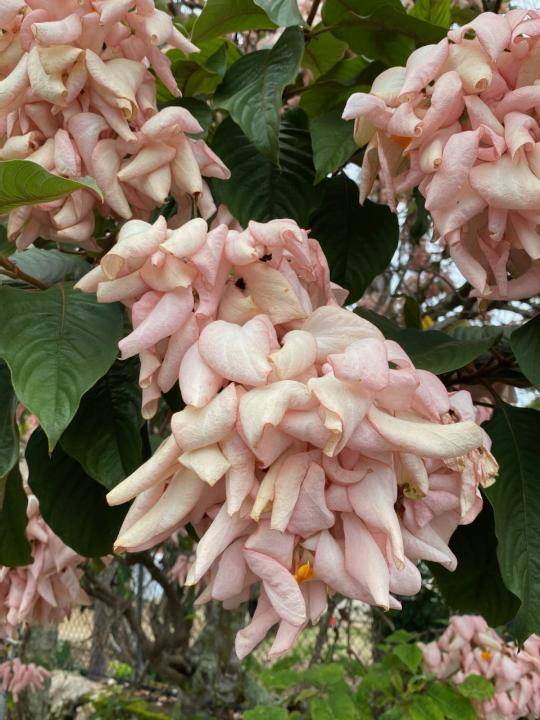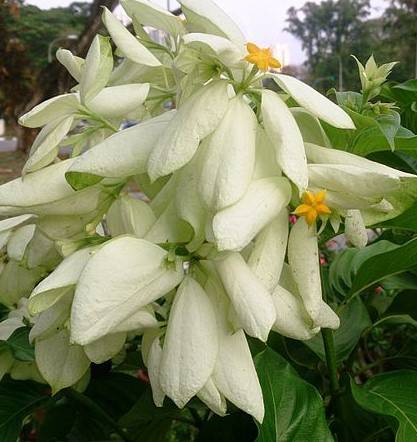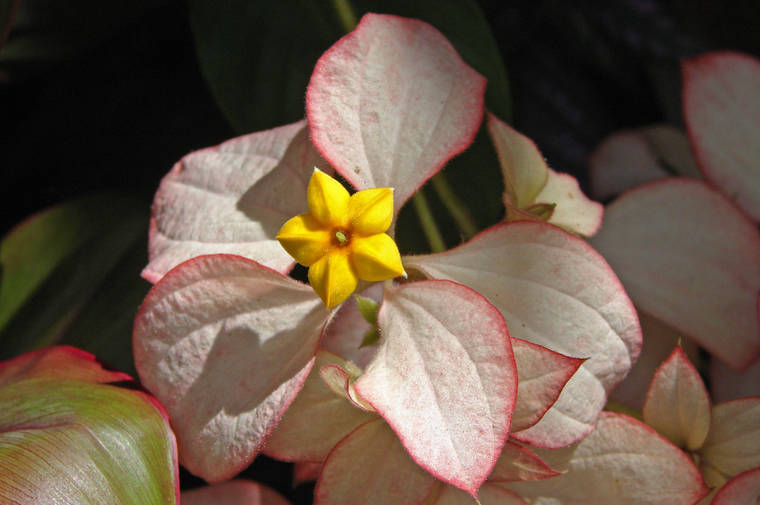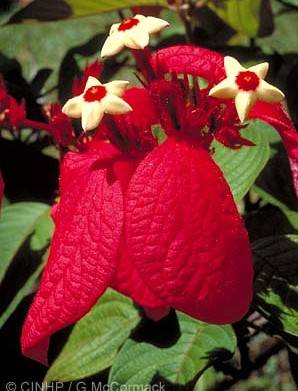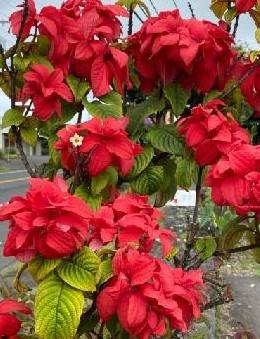Summer is peak season for beautiful flowering plants here in Kona. One that definitely qualifies as eye candy is the gorgeous mussaenda. Specimens of this lovely plant can be found in Kona with a few mature plants gracing the edge of the driveway into the former Kaiser clinic, which was once Sakamoto Electric Co. in Kealakekua. These plants are fully mature and manage to put on a floral display most of the summer.
Mussaenda is the genus name that identifies the many cultivars of this species. All are in the Rubiaceae (Coffee) family, which includes our well known coffee plant well as gardenia and ixora species. Though some plants in the mussaenda genus originated in Africa and India almost all have been cultivated in the Philippines. The University of the Philippines continues to develop new cultivars, naming most of them for Philippine first ladies known as “Dona.”
Though the botanical name mussaenda is applied to all of the 200 species in this genus, common names like tropical dogwood and Bangkok rose are sometimes used. Despite the numerous cultivars that are grown worldwide, only a few are available here.
The distinguishing feature of all mussaenda is the colorful bracts or calyx lobes that gracefully drape around and below its small star-shaped tubular flowers. The resulting appearance is a colorful cascade falling among the large dark green leaves of the species. Though usually classified as a shrub, some mussaenda can grow to over 30 feet tall while others determine at 10 to 15 feet. They all bloom nearly year round, peaking mid-summer.
The bright red West African cultivar Mussaenda erythophylla, sometimes known as Ashanti blood has been cultivated by Philippine botanists and named “Dona Trining.” I have seen this grown in pots, locally. “Dona Aurora” with white calyx lobes or bracts is popular in Hawaii as is “Queen Sirikit’ named for the former queen of Thailand. Several others that are grown here include two pink cultivars “Dona Alicia” and “Dona Luz.”
The “Queen Sirikit” cultivar is supremely beautiful with light pink lobes that are each rimmed in a darker pink. The draping display is enhanced by the small bright yellow flower at its center. Philippine botanists named this cultivar commemorating the Thai queen’s visit to the Philippines in 1963.
Three close mussaenda relatives that are sometimes found in Hawaii include M. frondosa, an Indian native plant, and M. raiateensis, from the South Pacific, as well as M. phillippica “Aurorae,” a Philippine native. Each produces white lobes that are somewhat less showy than the previously named cultivars.
The large dark green leaves of the mussaenda can be up to 6 inches long. They remain on the plant year round. even when blossoms fade, making mussaenda an attractive hedging plant as well as an excellent single specimen.
Most of the varieties that grow here produce sterile seeds. The best propagation method is to grow new plants from cuttings. Time and attention are required to succeed, however.
If you do acquire cuttings, they may take a while to root. Remove any blossoms and most of the leaves then dip the cut end in a rooting compound and place it in a 50:50 mix of vermiculite and perlite. Keep the medium moist and wait. The cutting may take months to root.
When planting a mussaenda, choose a spot with plentiful rainfall or good irrigation and rich slightly acidic soil. A location in full sun at upper elevations will work well but at lower elevations select a site that gets afternoon cloud cover. This species cannot tolerate the salt spray in coastal gardens nor is it wind tolerant.
Though healthy mussaenda plants seldom are attached by insects or diseases, inspect them regularly and treat if you see a problem. Treatment with Safer soap and neem oil will take care of most insect attacks.
You only need to prune a mussaenda if you want to shape it. Regular fertilizing with a balanced product will help them to thrive.
If you have trouble finding the mussaenda cultivar you want for sale, see if Margo from Sunrise can help you. She’s at 640-9191. You can also look for it around town. If it is on private property, of course, you should inquire with the owner before taking any cuttings. Alternatively, you can just look for local specimens to enjoy their beauty where they are. Enjoy mussaenda, wherever you find them, they are a delight to see.
Diana Duff is a plant adviser, educator and consultant living part time in Kailua-Kona.
Summer is peak season for beautiful flowering plants here in Kona. One that definitely qualifies as eye candy is the gorgeous mussaenda. Specimens of this lovely plant can be found in Kona with a few mature plants gracing the edge of the driveway into the former Kaiser clinic, which was once Sakamoto Electric Co. in Kealakekua. These plants are fully mature and manage to put on a floral display most of the summer.
Mussaenda is the genus name that identifies the many cultivars of this species. All are in the Rubiaceae (Coffee) family, which includes our well known coffee plant well as gardenia and ixora species. Though some plants in the mussaenda genus originated in Africa and India almost all have been cultivated in the Philippines. The University of the Philippines continues to develop new cultivars, naming most of them for Philippine first ladies known as “Dona.”
Though the botanical name mussaenda is applied to all of the 200 species in this genus, common names like tropical dogwood and Bangkok rose are sometimes used. Despite the numerous cultivars that are grown worldwide, only a few are available here.
The distinguishing feature of all mussaenda is the colorful bracts or calyx lobes that gracefully drape around and below its small star-shaped tubular flowers. The resulting appearance is a colorful cascade falling among the large dark green leaves of the species. Though usually classified as a shrub, some mussaenda can grow to over 30 feet tall while others determine at 10 to 15 feet. They all bloom nearly year round, peaking mid-summer.
The bright red West African cultivar Mussaenda erythophylla, sometimes known as Ashanti blood has been cultivated by Philippine botanists and named “Dona Trining.” I have seen this grown in pots, locally. “Dona Aurora” with white calyx lobes or bracts is popular in Hawaii as is “Queen Sirikit,” named for the former queen of Thailand. Several others that are grown here include two pink cultivars “Dona Alicia” and “Dona Luz.”
The “Queen Sirikit” cultivar is supremely beautiful with light pink lobes that are each rimmed in a darker pink. The draping display is enhanced by the small bright yellow flower at its center. Philippine botanists named this cultivar commemorating the Thai queen’s visit to the Philippines in 1963.
Three close mussaenda relatives that are sometimes found in Hawaii include M. frondosa an Indian native plant and M. raiateensis from the South Pacific as well as M. phillippica “Aurorae,” a Philippine native. Each produces white lobes that are somewhat less showy than the previously named cultivars.
The large dark green leaves of the mussaenda can be up to 6 inches long. They remain on the plant year round. even when blossoms fade, making mussaenda an attractive hedging plant as well as an excellent single specimen.
Most of the varieties that grow here produce sterile seeds. The best propagation method is to grow new plants from cuttings. Time and attention are required to succeed, however.
If you do acquire cuttings, they may take a while to root. Remove any blossoms and most of the leaves then dip the cut end in a rooting compound and place it in a 50:50 mix of vermiculite and perlite. Keep the medium moist and wait. The cutting may take months to root.
When planting a mussaenda, choose a spot with plentiful rainfall or good irrigation and rich slightly acidic soil. A location in full sun at upper elevations will work well but at lower elevations select a site that gets afternoon cloud cover. This species cannot tolerate the salt spray in coastal gardens nor is it wind tolerant.
Though healthy mussaenda plants seldom are attached by insects or diseases, inspect them regularly and treat if you see a problem. Treatment with Safer soap and neem oil will take care of most insect attacks.
You only need to prune a mussaenda if you want to shape it. Regular fertilizing with a balanced product will help them to thrive.
If you have trouble finding the mussaenda cultivar you want for sale, see if Margo from Sunrise can help you. She’s at 640-9191. You can also look for it around town. If it is on private property, of course, you should inquire with the owner before taking any cuttings. Alternatively, you can just look for local specimens to enjoy their beauty where they are. Enjoy mussaenda, wherever you find them, they are a delight to see.
Diana Duff is a plant adviser, educator and consultant living part time in Kailua-Kona.
Gardening Events
Saturday: “Work Day at Amy Greenwell Garden” from 9 a.m. to 12:30 p.m. Meet at the Garden Visitor Center across from the Manago Hotel in Captain Cook. Volunteers will be able to help with garden maintenance and are invited to bring a brown bag lunch. Water and snacks provided. Call Peter at 323-3318 for more information.
Farmer Direct Markets
Wednesday: “Ho’oulu Farmers Market” at Sheraton Kona Resort &Spa at Keauhou Bay
Saturday: “Keauhou Farmers Market” 8 a.m. to noon at Keauhou Shopping Center
“Kamuela Farmer’s Market” 7:30 a.m. to noon at Pukalani Stables
“Waimea Town Market” 7:30 a.m. to noon at the Parker School in central Waimea
“Waimea Homestead Farmers Market” from 7:30 a.m. to noon at the Waimea middle and elementary school playground
Sunday: “Pure Kona Green Market” 9 a.m. to 2 p.m. at Amy Greenwell Garden in Captain Cook
“Hamakua Harvest” 9 a.m. to 2 p.m. at Highway 19 and Mamane Street in Honokaa







